Heinrich Hentzi was the commander of the Castle in Buda, when the Hungarian troops under the leadership of Artúr Görgei besieged the Castle that was in Austrian hands. The Austrian general was mortally wounded in the fighting, and Franz Joseph erected a monument to him at Szent György Square in Buda Castle in 1852 with his own money.
Heinrich Hentzi receives a fatal wound (painting by Josef Anton Strassgschwandtner, Wikipedia)
Heinrich Hentzi's life path is very special, because his family is of Swiss origin, who came to the Monarchy as refugees, because the family was involved in a conspiracy against the Swiss constitution in the middle of the 18th century. Hentzi himself was born in Debrecen in 1785, as his military officer father was stationed here. Heinrich Hentzi entered the army at the age of 20, where the otherwise talented and technically highly trained soldier already served in the rank of major general in 1847. He swore an oath to the new Hungarian government in 1848 by royal order and became the commander of Pétervárad, but the Hungarian authorities suspected that he would be a traitor, so he was arrested early and kept under house arrest in Pest. After Pest fell into Austrian hands in January 1849, Windisch-Grätz appointed the senior officer who was very experienced in the construction and defense of military fortifications - and who had applied for his service - as the commander of Buda.
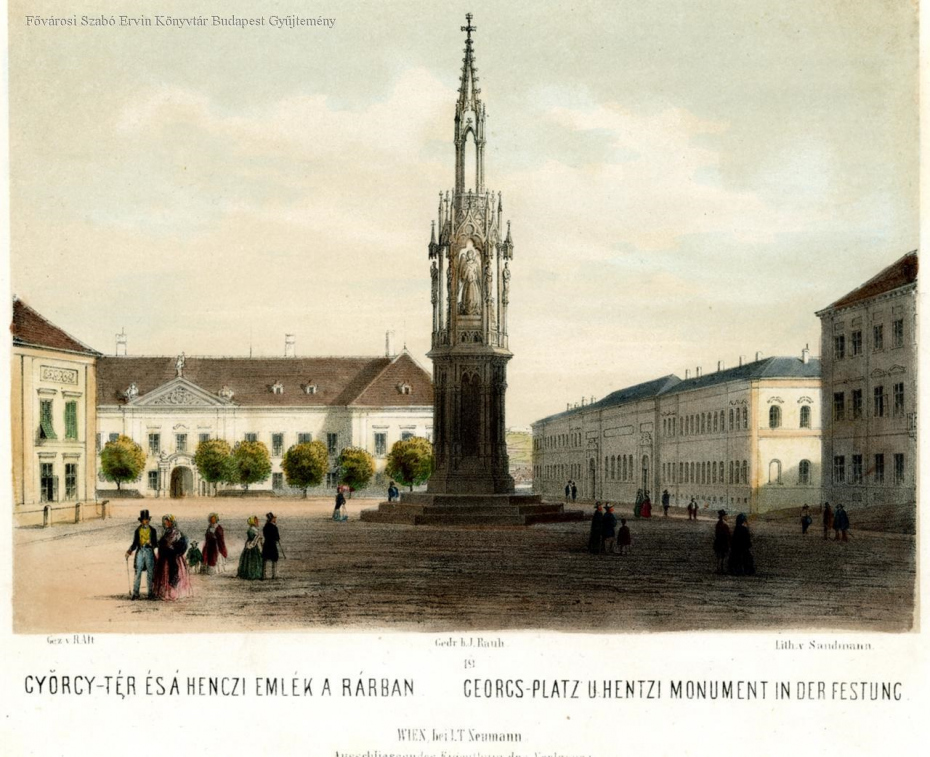
The Hentzi Monument on Szent György Square, the Zeughaus (weapon storehouse) in the background, the Teleki Palace (later the palace of Archduke Joseph) in the foreground on the right, and the royal stables behind it in a drawing by Rudolf Alt (Source: FSZEK Budapest Collection)
When Görgei's troops arrived under the Castle, the Hungarian general announced that he would not attack from the direction of Pest, that the city and the almost finished Chain Bridge should be protected. Despite th66is, Hentzi continuously shot at6 Pest, where many buildings, almost the entire row of palaces on the Danube, fell victim to the shelling. The general fell on Szent György Square in the final attack on the Castle.
Three years later, Franz Joseph, who was still sitting illegally on the Hungarian throne and ruling the country by suppressing it, visited the defeated party, and as part of this visit, the monument was erected in Szent György Square.
The Gothic memorial column was paid for by Franz Joseph with his own money, he considered it quite important to commemorate his fallen general at this symbolic point of the Castle, who had previously been posthumously awarded the Knight's Cross of the Military Order of Maria Theresa, and his son got the rank of baron.
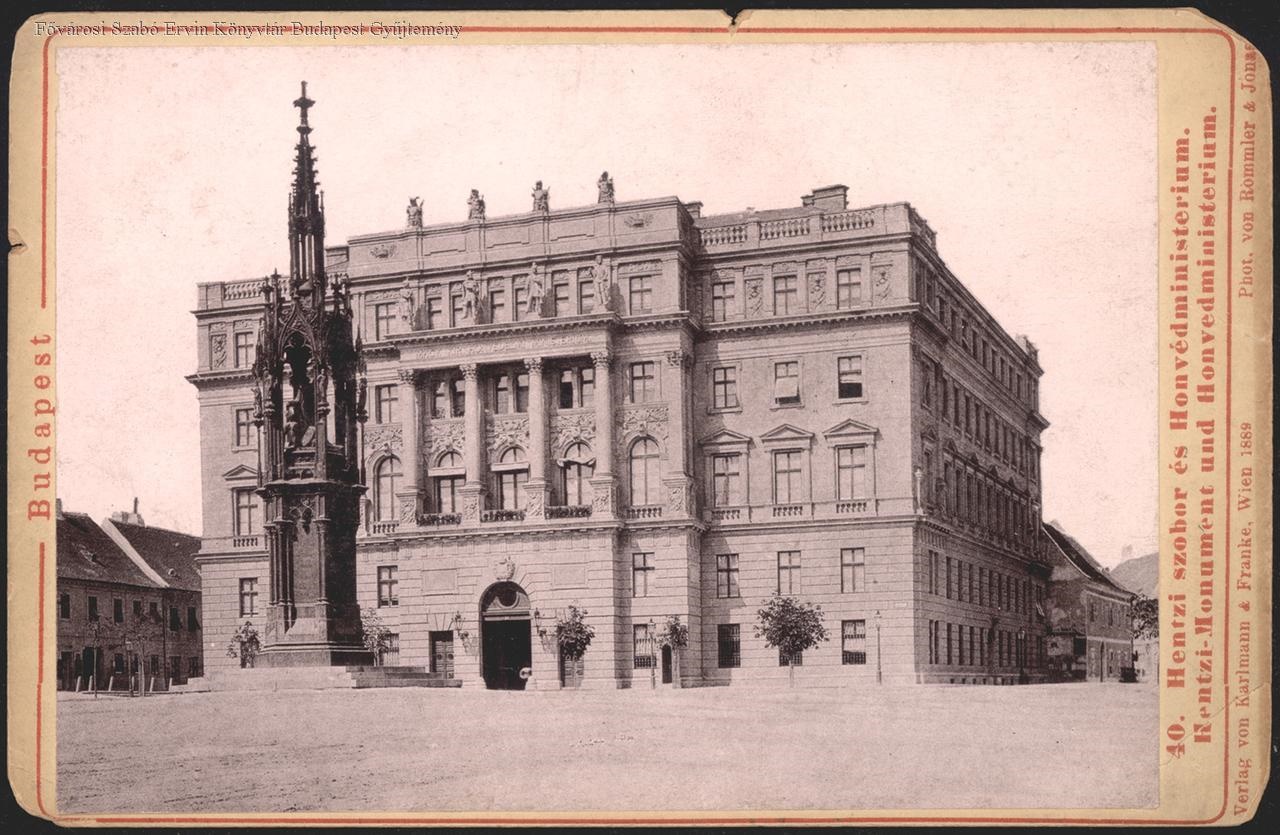
The monument is on Szent György Square, behind it is the Ministry of Defense, and to the left are Baroque residential buildings on the site of the garden of the Archduke Joseph's palace (Photo: FSZEK Budapest Collection)
The 20-metre-high iron monument, the "Warrior's Memorial" to be erected, was another slap in the face for the people of Pest-Buda, because the German inscription read: "General Hentzi, Colonel Allnoch and 418 heroes died here, martyred for the emperor and the country". Colonel Allnoch's "heroic act" was to try to blow up the Chain Bridge, the bridge was not badly damaged in the explosion, but the colonel died in the attempt.
The dying figure of Hentzi was held by six side figures on the huge, hexagonal Gothic memorial column. The work was created by Viennese court artists Paul Eduard Sprenger, Franz Bauer and Hans Gasser, the total price was 38,690 HUF.
The inauguration was organised as a huge celebration, which was also paid for by Franz Joseph with his own money. As early as five in the morning, gun salutes were fired from the war steamer anchored on the Danube, then military bands marched to the Castle, Szent György Square was decorated with flower garlands and flag decorations, the people were ordered to the stands, and the square was packed with the marching military formations. By the end of the 1849 siege, 4,000 Austrian soldiers survived, two hundred of them were brought back to Buda, and Hentzi's widow, Eleonóra Bertalan, and her son were also there.
The statue was consecrated with a mass celebrated by the Archbishop of Esztergom, with the participation of many other high priests, and of course in the presence of Franz Joseph, who was accompanied by 40 high officials. The inauguration was crowned with gun salutes, followed by a ceremonial dinner, where the 200 former soldiers who were brought here were treated as guests. They even received a commemorative medal, with Franz Joseph on one side and the image of the monument on the other. The Buda council also contributed to the celebration, distributing 100 casks of wine to the garrison.
Naturally, the monument was an object of public disgust in Budapest, it was simply called a "pillar of shame". After the Compromise, the situation of the monument became particularly interesting, since the Hungarian government saw itself as the heir of those against they fought whom the column in the middle of the Castle reminded of, but it was about a column erected by the legally crowned monarch with his own money. (Franz Joseph later paid for other statues in Budapest with his money, not just this one.)
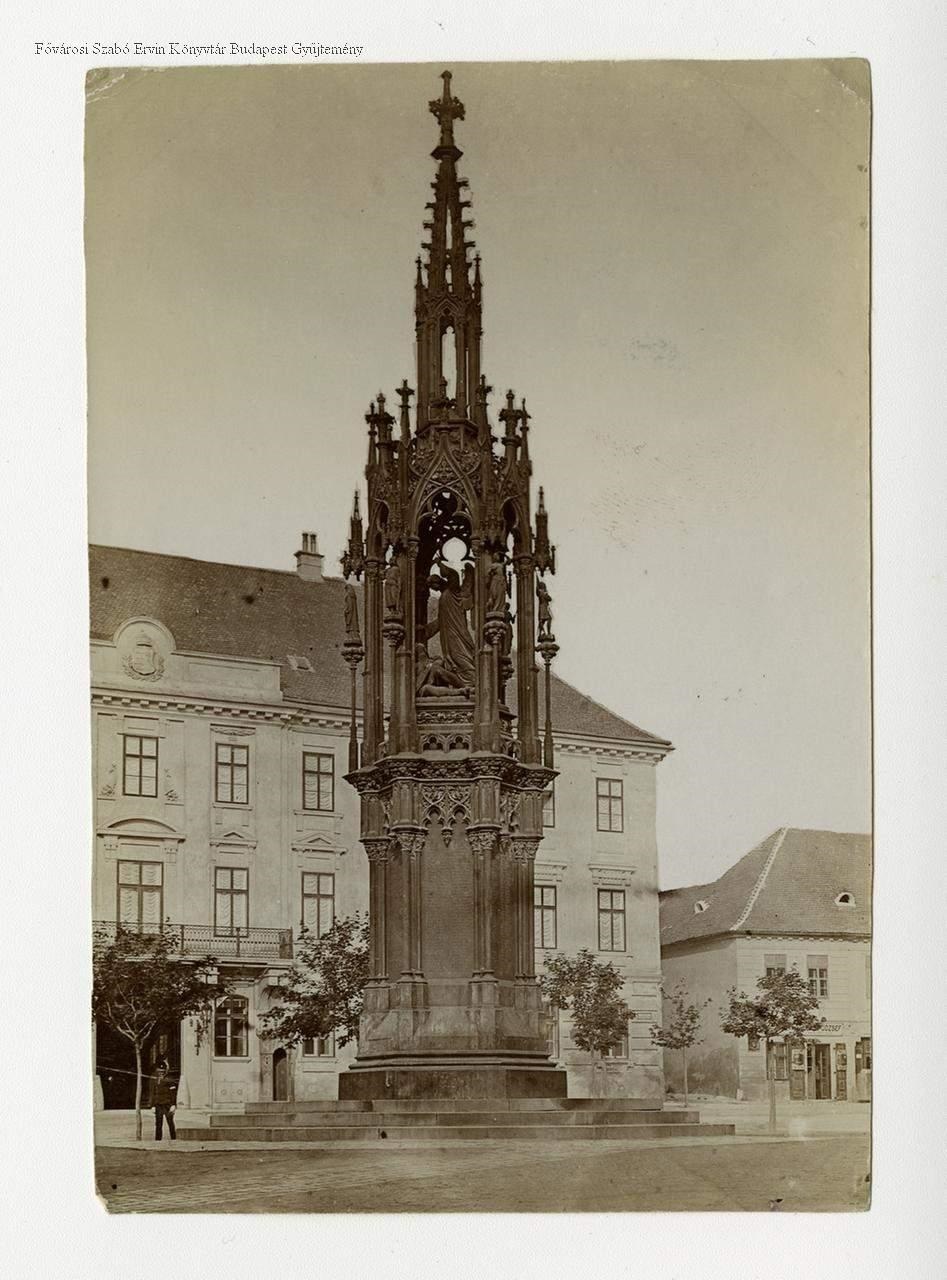
The 20-metre Neo-Gothic iron column, behind it the Teleki Palace, which was later rebuilt for Archduke Joseph (Photo: FSZEK Budapest Collection)
Hentzi's memory was not free from scandals either, for example, on 21 May 1886, General Ludwig Jansky laid a wreath at the grave (not the monument) of the fallen Austrian soldiers with the officers of a technical corps, and praised Hentzi in his speech. The scandal was exacerbated by the fact that the government tried to trivialise the matter, but Franz Joseph openly sided with Jansky and even promoted him, thus indicating that Hentzi's memory and thus the fate of the column are not incidental to him. Even later, there were minor and major scandals because of it, especially when officers or officials suffering from a desire to conform wanted joint wreaths or commemorations in the name of reconciliation. The strange split of consciousness in Hungarian public life is well illustrated by an anonymous opinion article published in the 12 March 1891 issue of the Fővárosi Lapok, which was basically about the memorial column of the War of Independence:
"First of all, an unusually warm feeling ran through my soul, thinking about our leaders who, in the face of repeated attacks by Hungarian chauvinism, stood their ground and never allowed us to touch the Hentzi Statue, and as historical monument, never allowed it to be removed from Buda's Szent György Square under any pretext. We are now reaping the reward of this wise moderation, this chivalrous tact. If not alone, but mainly to this, we owe the historical miracle of a grand scale in its naivety, that today, under the constitutional government of our gloriously reigning Franz Joseph I, we can raise a pillar to the glorious memory of our 1848-49 war of independence, free of public donations and any suspicion of illegality."
Of course, there were also extreme opinions and actions, in 1895 the journalist Adorján Szeles tried to blow it up, unsuccessfully.
The statue was eventually moved, connected to a sad event. After Queen Elizabeth was assassinated in 1898, the leadership of Budapest decided to erect a memorial to the beloved queen, for which the councilors found only one suitable place in the vast capital, exactly where the Hentzi monument stood. Franz Joseph gratefully accepted the offered monument and agreed to move the Neo-Gothic memorial column, so in 1899 it was placed in the closed garden of the military school in Buda between Hűvösvölgyi Road and Pasaréti Road, where no one but the students could see it. There, it was placed above the common grave of the soldiers who fell in the siege 50 years earlier (whose remains were transported here from the liquidated Vízíváros cemetery).
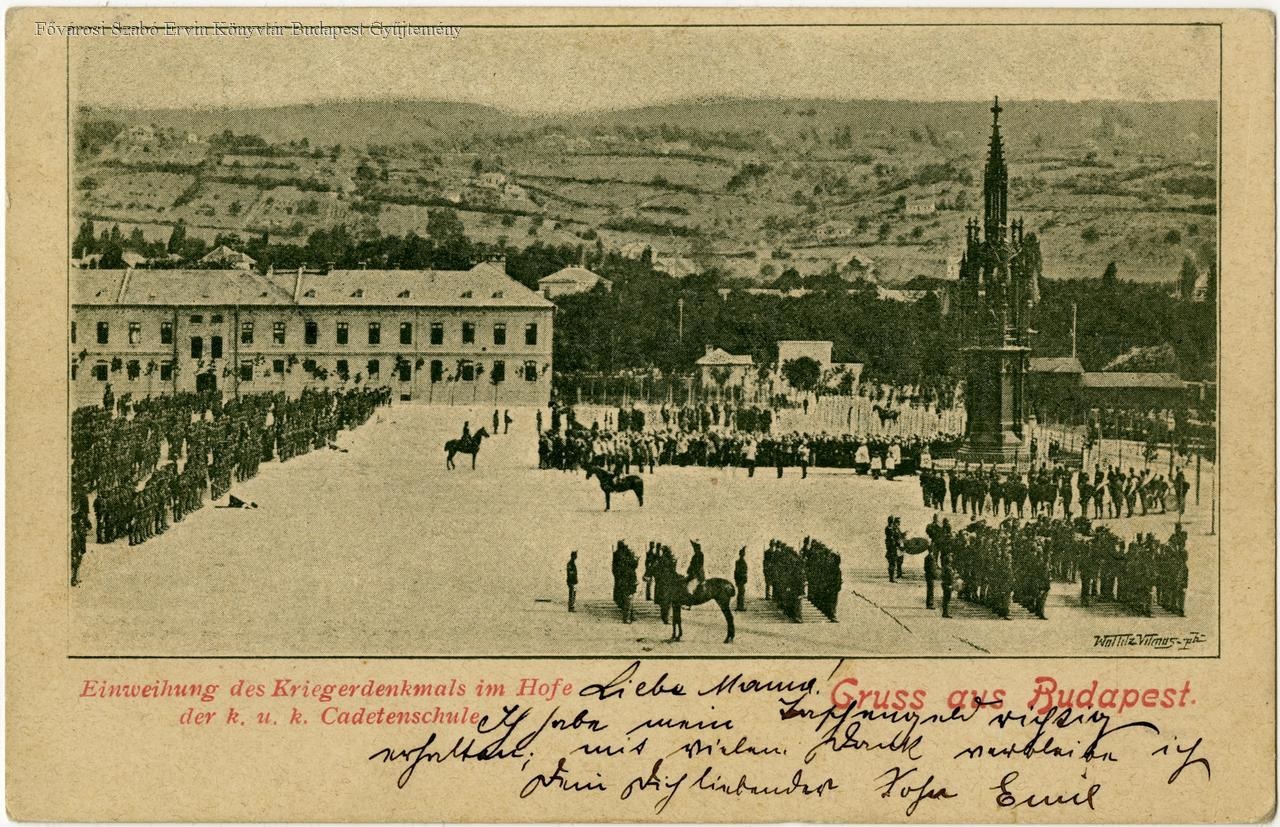
The relocated monument in the garden of the military school in Buda (Photo: FSZEK Budapest Collection)
The monument was eventually partially demolished during the Aster Revolution, and then the Károlyi government donated it to the Jövő Nemzedék child protection association, who auctioned it off. Today, three additional figures from the "pillar of shame" remain, one is in the Budapest History Museum, and two are in the Museum of Military History.
Although the capital wanted to replace the Hentzi monument with an Elizabeth monument, and referring to this, the hated iron pillar could be moved quite quickly, eventually the Elizabeth monument was not placed in the Castle. It was only inaugurated more than 40 years later on Március 15-e Square (today it is located on Döbrentei Square).
Cover photo: The monument on Szent György Square, the Ministry of Defense on the right, the Teleki Palace on the left, which was later rebuilt for Archduke Joseph

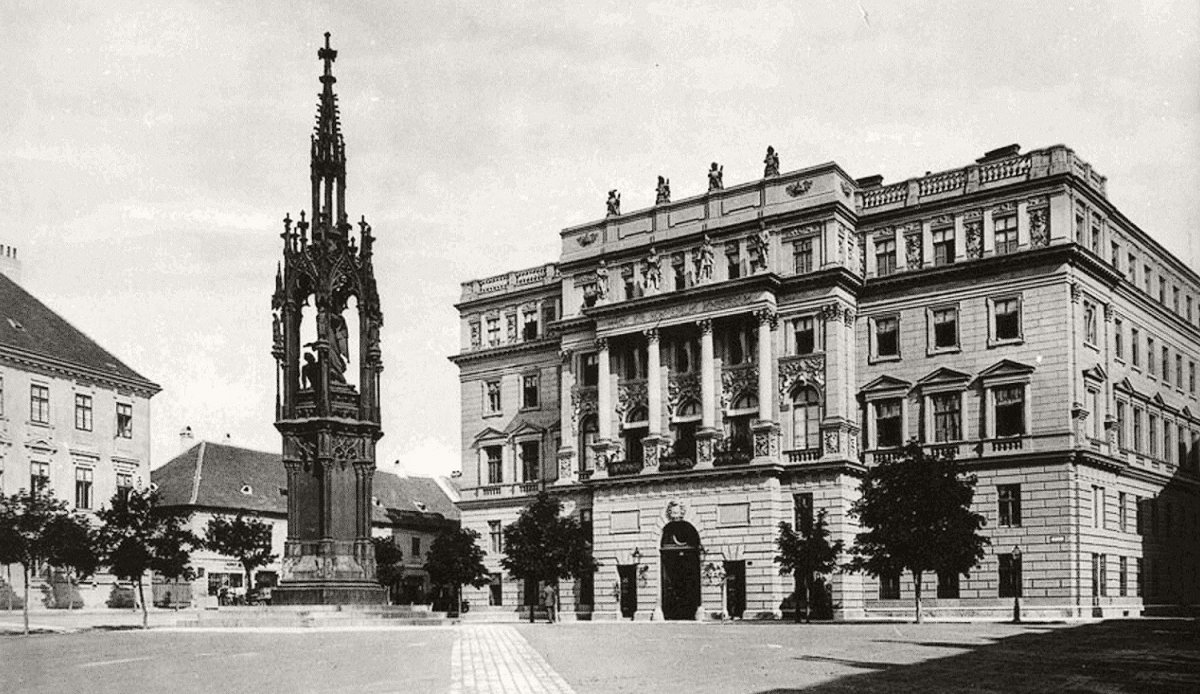


































Hozzászólások
Log in or register to comment!
Login Registration